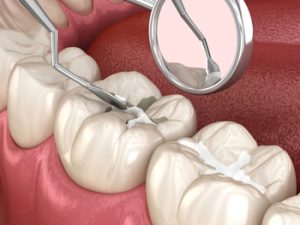When it comes to defending teeth against decay, few preventive measures are as quick, gentle, and effective as the fissure sealants procedure. By flowing a protective resin into the deep grooves on the chewing surfaces of molar teeth, dentists can lock out food particles, bacteria, and sticky plaque before they ever have a chance to do harm. Below, you’ll find everything you need to know about fissure sealants, how the sealant procedure unfolds in real‐world practice, and why it sits so high on the dental care priority list for both children and adults in Australia.
What Exactly Are Fissure Sealants?
A fissure sealant is a thin, tooth-coloured material that flows easily into the natural fissures, pits and grooves of back teeth and then sets hard. You might also hear the terms dental sealants, dental fissure sealants, or simply sealants. All describe the same preventive coating.
Because the tooth surface of premolars and molars is anything but flat, debris tends to settle inside those microscopic channels and start causing tooth decay. A well-placed sealant creates a smooth barrier so that nothing can lodge inside and ferment. Think of it as waterproofing your new deck before the first rainy season: a small upfront effort that prevents a whole lot of rot down the track.
Why the Chewing Surfaces of Molars Need Extra Help
 Molars and back molars do the heavy lifting of grinding food, and their rugged design, which is full of tiny pits, sneaky grooves, and winding fissures, makes cleaning with a brush alone tricky. Worse, shortly after tooth eruption, fresh enamel is softer and more susceptible to dental decay. Salivary minerals toughen the surface over time, but that early window is an open invitation for plaque.
Molars and back molars do the heavy lifting of grinding food, and their rugged design, which is full of tiny pits, sneaky grooves, and winding fissures, makes cleaning with a brush alone tricky. Worse, shortly after tooth eruption, fresh enamel is softer and more susceptible to dental decay. Salivary minerals toughen the surface over time, but that early window is an open invitation for plaque.
Add in typical children’s diets (think sticky snacks, high-frequency grazing), and you have the perfect storm for premature decay. Even adults with pristine brushing techniques sometimes miss debris wedged in a fissure. That’s why preventive fissure sealing is considered a widely recommended practice in modern paediatric dentistry and is increasingly popular for adult molars, too.
Ideal Timing and Candidacy
The sweet spot for fissure sealant treatment is soon after the permanent six-year molars erupt, generally between ages six and eight, because the tooth is still pristine and unspoiled by acids or sugar bugs. A child with deep anatomy, developmental grooves, or early chalky spots is a textbook candidate.
However, it’s never “too late”. Adults with no fillings on the chewing surfaces, patients with a heightened risk of cavities, or those undergoing orthodontic work that traps food around brackets can also benefit. As long as the tooth is sound and the fissures are stain-free or only lightly stained, a dentist can place a sealant to protect it for years.
Step-by-Step: The Dental Fissure Sealant Procedure
Below is a walk-through of the evidence-based dental fissure sealant procedure used in Australian clinics. Note how simple and comfortable it is from the patient’s point of view.
Assessment and Cleaning
The dentist begins by checking that there are no hidden cavities or early signs of dental decay in the pits and grooves of the tooth surface. If the area appears sticky or stained, they may gently clean it using a small bur or air abrasion. The goal is to ensure only healthy enamel is sealed during the fissure sealant procedure.
Isolation
To prevent saliva from interfering with bonding, the tooth is kept dry using a cotton roll or a small rubber dam. Moisture control is essential for the sealant placement to last.
Etching
A mild acid gel is applied to the chewing surface for 20–30 seconds. This roughens the enamel microscopically and improves retention. It also helps the fissure sealant adhere firmly to the surface during application.
Rinsing and Drying
After the gel is rinsed away, the tooth is dried with air until the enamel looks chalky white, which is an indication it’s ready for sealing. This step is generally comfortable and requires no anaesthetic.
Sealant Application
The liquid dental fissure sealant is carefully applied to flow into the deep grooves, fissures, and pits of the tooth. It fills all the areas where plaque and bacteria could otherwise settle, causing tooth decay. This is the key step in fissure sealing, especially on newly erupted molars or adult molars with no previous restorations.
Light Curing
A specific blue LED light is used to harden the sealant in just a few seconds. This polymerises the material, making the tooth safe to eat on right away.
Checking for Excess
The dentist checks the bite to ensure everything feels natural. Any excess sealant or excess material is trimmed to avoid discomfort or premature wear.
Final Polish and Fluoride Varnish
To complete the treatment, the sealed tooth may be lightly polished, and a layer of fluoride varnish may be applied. This strengthens the enamel further and provides additional protection against decay.
From start to finish, the sealant procedure takes less than ten minutes per tooth. Most patients find it quick, minimally invasive, and well-tolerated. No needles, no drilling, and no downtime. It’s a straightforward way to give teeth an extra layer of long-term oral health protection.
After-Care: Keeping Your Sealant Strong
Once the resin is cured, you can eat right away. Just be mindful of the first hour if the dentist recommends avoiding very hard or chewy foods.
 To maximise lifespan:
To maximise lifespan:
- Maintain regular checkups on a regular basis, usually twice a year, so your dentist can ensure the coating hasn’t chipped or partially worn.
- Continue routine oral health habits: gentle brushing twice daily with fluoridated paste, cleaning between teeth, and limiting sugary snacks.
- Call if the molar suddenly feels rough; lost material can often be replaced in minutes.
Modern resin tends to last anywhere from three to ten years, but even partial seals significantly cut the odds of dental decay developing underneath. Refreshing is quick and inexpensive.
The Science-Backed Benefits
Research consistently shows that sealed molars experience up to an 80 % reduction in tooth decay compared with unsealed controls. That’s not magic; it’s straightforward physics: when you block microscopic entry points, fermentable carbohydrates and acid-producing bacteria cannot occur in contact with enamel.
Additional advantages include:
- Protect against early caries during the vulnerable post-eruption window.
- Save patients from invasive drilling and filling later in life.
- Lower cumulative dental spending is an attractive prospect in today’s cost-of-living climate.
- Provide peace of mind for parents, knowing their child has an added layer of armour on those irreplaceable adult teeth.
Common Questions Answered
Not sure what to expect? Here are answers to FAQs.
Do fissure sealants feel different?
Most people forget they’re there within a day. The surface may feel glossy at first, but your tongue soon adapts.
Is an injection needed?
No anaesthetic is necessary; only the enamel is treated, and the enamel has no nerves.
What if a small cavity is found first?
Minor, non-cavitated lesions can sometimes be sealed over after careful preparation. Your clinician will advise if a tiny preventive filling or full restoration is wiser.
Do sealants replace fluoride?
Not at all. Sealants and fluoride work best together: one acts as a physical barricade, and the other chemically strengthens enamel.
Are there any downsides?
Very few. Rarely, excess material left in a high spot can feel annoying; your dentist will adjust the bite. Some people have mild allergies to resin compounds, though that’s extremely uncommon.
Can adults request the treatment?
Absolutely. Many practices now include sealants in their preventive treatment menu for teens, athletes, and anyone with pristine but ridge-ridden molars.
The Role of Sealants in a Broader Prevention Plan
While a fissure sealant treatment is a powerful weapon, it thrives as part of a holistic approach that also values diet, fluoride, and mechanical plaque removal. Encourage children to drink water after snacks, choose tooth-friendly food on school days, and brush diligently before bed.
At your six-monthly recall, clinicians won’t just inspect the integrity of existing fissure sealants. They will screen growth patterns, monitor spaces for wisdom teeth, and discuss lifestyle updates that may introduce new risk factors. Prevention is a conversation, not a one-off act.
In a Nutshell
- The chewing surfaces of adult molars and kids’ back molars are prime real estate for bacteria.
- A professionally applied fissure sealant fills in those tricky contours, so fermentable debris can’t lodge and start decay.
- The fissure sealant procedure is comfortable, needle-free, and finished in minutes.
- With sensible after-care and regular checkups, sealants can outlast childhood and safeguard smiles well into adulthood.
If you’re concerned about food or bacteria getting trapped in molar grooves or simply want to give your teeth extra protection against decay, book a consultation with us at Beyond Infinity Dental or call (02) 8806 3799. Together, we’ll work out the right timing and approach for your smile.
Resources
Mitchell, K. (2025). ‘What Are Dental Sealants?’. WebMD, 20 March. New York, NY: WebMD LLC.
https://www.webmd.com/oral-health/dental-sealants
WebMD Editorial Contributors. (2024). ‘Preventing Tooth Decay’. WebMD, 15 October. New York, NY: WebMD LLC.
https://www.webmd.com/oral-health/tooth-decay-prevention
Cleveland Clinic. (2023). ‘Tooth Enamel’. Cleveland Clinic, 3 June. Cleveland, OH: Cleveland Clinic.
https://my.clevelandclinic.org/health/body/24798-tooth-enamel









